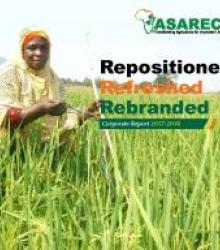| Title | Author | Asbract |
|---|---|---|
| Biotechnology: toewards a regional policy on GMO crops among COMESA/ASARECA countries | ASARECA | |
| Agricultural production and soil nutrient mining in Africa: implications for resource conservantion and policy development | ASARECA | |
| Farmer Field Schools: A boon or bust for agricultural extension in Africa? | ASARECA | Farmer Field Schools: A boon or bust for agricultural extension in Africa? |
| Gender and development: bridging thegap between research and action | ASARECA | Gender and development: bridging the gap between research and action |
| The role of non-GM biotechnology in developing world agriculture | ASARECA | In the intense debates around the applications of modern biological research to agriculture and food production, genetic modification (GM techniques)—and the novel crops that result from their application—tends to attract the lion’s share of public attention. This is despite the fact that such research offers a range of other tools and techniques that do not involve genetic modification, and yet can still make major contributions to agriculture. One result of the disproportionate focus on GM crops is that policymakers in the developing world often lack adequate information on the nature and potential use of non-GM biotechnologies. This briefing seeks to help fill this information gap by summarizing the characteristics of the most common non-GM biotechnologies that are being developed and applied to crop improvement in the developing world. It focuses on four types of non-GM biotechnology: tissue culture, molecular markers, diagnostic techniques and microbial products. |
| Accelerating pro-poor growth: policy and institutional options for decision makers | ASARECA | Over the last forty years, demand for food in developing countries has increased more than threefold. In response, these countries have increased their production of irrigated crops from two to fourfold. As a result, average yield has more than doubled for rice and maize, trebled for wheat, and quadrupled for fruits and vegetables. Water productivity has increased sharply during the same time. However, these gains have been neither universally successful nor universal in scope. Governments led the expansion of large-scale irrigation, and the results have been mixed, with many supply-led and bureaucratic programs producing disappointing results. In many basins, water productivity remains startlingly low, and adoption of modern technology is slow. |
| Using their own evidence: building policy capacities in the south | ASARECA |
Capacity building in policy research is a major concern in sub-Saharan Africa and is a core subject in ECAPAPA’s agenda. This article by Stephanie Neilson of the International Development Research Center (IDRC) provides some useful insights on how the IDRC-supported research and its partners are contributing to the generation and production of research results that are being used for policy formulation and policy change. |
| In light of its evolution as the instrument of research organizations of the region, ASARECA’s mission is “fighting poverty, reducing hunger and enhancing resources through regional collective action in agricultural research for development.” ASARECA’s vi | ASARECA | Using their own evidence: building policy capacities in the south |
| Does policy research matter? Key issues about agriculture in Africa and the emerging development priorities for the new millennium | Does policy research matter? Key issues about agriculture in Africa and the emerging development priorities for the new millennium |
|
| ASARECAs role in reducing poverty and hungerin sub-Saharan Afirca | ASARECA | In light of its evolution as the instrument of research organizations of the region, ASARECA’s mission is “fighting poverty, reducing hunger and enhancing resources through regional collective action in agricultural research for development.” ASARECA’s vision is to be a significant player in facilitating innovation and making spillovers happen by ensuring that the benefits of research results in one country are available to all users and that mechanisms are developed to make the link with the national innovation systems. The mission highlights the organization’s commitment to the Millennium Development Goals (MDGs) to reduce poverty and hunger by half before 2015 and to sustain the productivity of the natural environment. |
Search
Newsletter
Copyright © 2025. All rights reserved.
Designed By ASARECA


